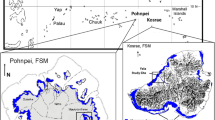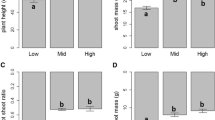Abstract
Above‐ground and below‐ground root biomasses (Babove and Broot) were measured for young, isolated Rhizophorastylosa on Iriomote Island, Japan. The relationship between these two parameters was significant and given as the equation, Broot (g dry weight) = 0.394 × Babove (g dry weight) − 485 (r = 0.986). Multiple regression analyses also revealed good correlation between diameter and biomass of prop roots (Dprop and Bprop) and between prop root and root biomasses. Consequently, root biomass could be estimated from the measurements of diameter and biomass of prop roots using the multiple regression equation, Broot (g dry weight) = 80.0 ×Dprop (cm) + 0.86 ×Bprop (g dry weight) − 251. The relationship between DBH (diameter at breast height) and prop root biomass was also adequately described using an allometric equation.
In Hinchinbrook Channel, Australia, redox potential (measured as Eh) and organic carbon stocks in the top 5 cm of mangrove sediments were measured along a 600 m transect from the frequently inundated, Rhizophora dominated zone on the creek edge, towards higher grounds, where Ceriops spp. became increasingly dominant. Eh values were about −60 mV near the creek edge and increased to 260 mV on higher grounds. Organic carbon stocks showed an opposite trend to Eh, with the values decreasing from about 360 t C ha−1 to 160 t C ha−1. At 18 sites, representing six different habitats, organic carbon stocks were also measured along with the DBH of mangrove trees. DBH was converted into above‐ground biomass and then into root biomass using the equations obtained in the study on Iriomote Island. The average organic carbon stocks in the top 50 cm of sediments, above‐ground biomass and root biomass were 296 t C ha−1, 123 t C ha−1 and 52 t C ha−1, respectively, and accounted for 64%, 25% and 11% of the total organic carbon stock.
Similar content being viewed by others
References
Clough, B. 1992. Primary productivity and growth of mangrove forests. pp. 225–249. In: Robertson, I.A. and Alongi, D.M. (eds), Tropical Mangrove Ecosystems. American Geophysical Union, Washington.
Brown, S. and Lugo, A.E. 1982. The storage and production of organic matter in tropical forests and their role in global carbon cycle. Biotropica 14: 161–187.
Chan, Y. 1982. Storage and release of organic carbon in Peninsular Malaysia. Journal of Environmental Studies 18: 211–222.
Edward, P.J. and Grubb, P.J. 1977. Studies of mineral cycling in a montane rain forest in New Guinea. The distribution of organic matter in the vegetation and soil. Journal of Ecology 65: 943–969.
Fujimoto, K. and Miyagi, T. 1993. Development process of tidal-flat type mangrove habitats and their zonation in the Pacific Ocean. Vegetatio 106: 137–146.
Houghton, R.A., Hobbie, J.E., Melillo, J.M., Moore, B., Peterson, B.J., Shaver, G.R. and Woodwell, G.M. 1983. Changes in the carbon content of terrestrial biota and soils between 1986 and 1980: A net release of CO2 to the atmosphere. Ecological Monographs 53: 235–261.
Komiyama, A., Moriya, H., Prawiroatmodjo, S., Toma, T. and Ogino, K. 1988. Primary productivity of mangrove forest. pp. 97–117. In: Ogino, K. and Chihara, M. (eds), Biological System of Mangroves: A Report of East Indonesian Mangrove Expedition 1986. Ehime University, Matsuyama.
Komiyama, A., Ogino, K. and Sabhasri, S. 1987. Root biomass of mangrove forests in southern Thailand. 1. Estimation by the trench method and the zonal structure of root biomass. Journal of Tropical Ecology 3: 97–108.
Ong, J.E. 1993. Mangroves – a carbon source and sink. Chemosphere 27: 1097–1107.
Ohta, S. and Effendi, S. 1992. Ultisols of lowland dipterocarp forest in East Kalimantan, Indonesia. Status of carbon, nitrogen and phosphorus. Soil Science and Plant Nutrition 38: 207–216.
Tabuchi, R. 1995. Fine-root amount of young mangrove stands in Trang Province, Thailand. pp. 573–583. In: Box, E.O. et al. (eds), Vegetation Science in Forestry. Kluwer Academic Publishers, U.K.
Tsutsumi, T., Kan, M. and Khemanark, C. 1964. The amount of plant nutrients and their circulation in the forest soils in Thailand. Journal of Study for South-East Asia. 4: 95–126.
Woodroffe, C.D., Chappell, J., Thom, B.G. and Wallensky, E. 1989. Depositional model of a macrotidal estuary and floodplain, South Alligator River, Northern Australia. Sedimentolgy 36: 737–756.
Author information
Authors and Affiliations
Rights and permissions
About this article
Cite this article
Matsui, N. Estimated stocks of organic carbon in mangrove roots and sediments in Hinchinbrook Channel, Australia. Mangroves and Salt Marshes 2, 199–204 (1998). https://doi.org/10.1023/A:1009959909208
Issue Date:
DOI: https://doi.org/10.1023/A:1009959909208




